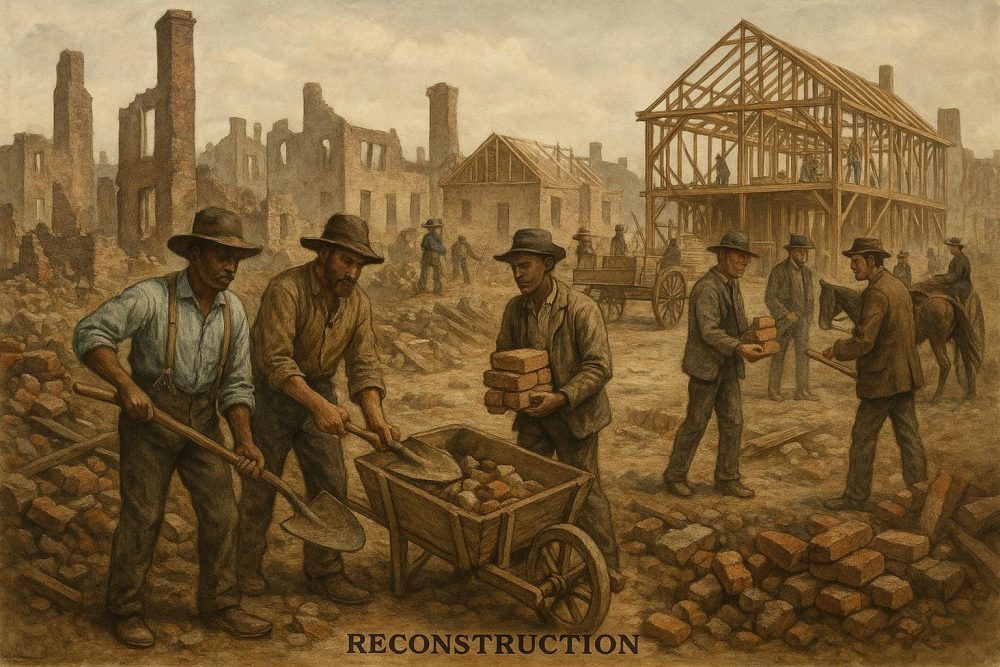
Introduction to Post-Civil War Reconstruction
The post-Civil War Reconstruction era in the United States was a transformative and complex period that lasted from 1865 to 1877, immediately following the end of the Civil War. The primary objectives of this era were to address the multifaceted challenges of reintegrating the secessionist Southern states back into the Union, repairing and revitalizing the region’s devastated infrastructure, and ensuring that newly freed African Americans were able to exercise their newly granted civil rights. These challenges were not merely logistical but also deeply political and social, requiring significant legislative and policy efforts.
Lincoln’s Approach to Reconstruction
President Abraham Lincoln initiated efforts towards Reconstruction with a strategy that could be characterized as moderate and conciliatory. His plan, which became known as the Ten Percent Plan, was crafted with the intent to reunify the nation in a manner that was swift and relatively painless. According to this plan, any Southern state could be readmitted into the Union once 10% of its voters swore an oath of allegiance to the Union. Lincoln’s approach was notably lenient and was centered around fostering national healing and reconciliation. He believed that a harsh punitive approach would only serve to widen the divisions and hinder the process of reunification.
Andrew Johnson’s Presidency and Policies
The trajectory of Reconstruction shifted following the assassination of Lincoln, with the ascension of President Andrew Johnson to office. Johnson adopted a similarly lenient approach to Reconstruction but found his policies mired in controversy and criticism. He was perceived as overly sympathetic to the Southern states. Johnson’s policies primarily involved the restoration of property rights to Southern landowners who pledged loyalty to the Union, with the notable exception of high-ranking Confederate officials. This approach garnered significant opposition from the Radical Republicans, a group within Congress that advocated for more stringent Reconstruction policies, arguing that leniency would fail to protect the rights of newly freed African Americans and to transform Southern society.
Radical Reconstruction
Radical Republicans, under the leadership of prominent figures such as Thaddeus Stevens and Charles Sumner, pushed for a more robust and transformative approach to Reconstruction. Their advocacy and influence led to the introduction and passage of several key legislative measures aimed at fundamentally changing Southern society and ensuring civil rights:
Civil Rights Act of 1866: One of the first significant legislative steps, this law granted citizenship and equal rights to African Americans, marking a monumental step forward in the struggle for racial equality.
14th Amendment: Ratified in 1868, this critical amendment provided citizenship to all people born or naturalized in the United States, including former slaves, and guaranteed equal protection under the law.
Reconstruction Acts of 1867: These acts divided the former Confederate states into five military districts, requiring each to draft new state constitutions that upheld the 14th Amendment. Before being readmitted to the Union, these states were required to include provisions for African American suffrage.
The Impeachment of Andrew Johnson
The relationship between President Johnson and the Radical Republicans deteriorated drastically, culminating in his impeachment in 1868. Johnson had been charged with violating the Tenure of Office Act—a law that he had previously vetoed. The House of Representatives voted to impeach him, but the Senate fell just one vote short of the necessary two-thirds majority needed to remove him from office. This impeachment episode did little to bridge the rift between Johnson and Congress, resulting in a further entrenchment of political divisions during the era.
The Reconstruction Era Amendments
The period of Reconstruction was marked by the ratification of three landmark constitutional amendments, each of which sought to address the issues of slavery and civil rights:
13th Amendment: Ratified in 1865, this amendment effectively abolished slavery throughout the United States, marking one of the most significant legal changes in American history.
14th Amendment: Beyond its provision for citizenship and equal protection, this amendment also addressed other issues related to states’ rights and federal authority, fundamentally altering the balance of power between state and federal governments.
15th Amendment: Ratified in 1870, this amendment was aimed specifically at protecting the voting rights of African American men, prohibiting any form of voter discrimination based on race, color, or previous condition of servitude.
Challenges During Reconstruction
Despite significant legal and constitutional advancements, the Reconstruction era was fraught with challenges and resistance. The Southern economy, which had been heavily reliant on slave labor, struggled to adapt to a new economic system devoid of slavery. This period also witnessed profound social tensions as various groups navigated the shifting societal landscape. Among the most notorious of the adversarial groups was the Ku Klux Klan, which actively opposed Reconstruction efforts and targeted African Americans and their allies with intimidation and violence.
End of Reconstruction
The official conclusion of the Reconstruction era came in 1877, largely as a result of the Compromise of 1877. This compromise involved the withdrawal of federal troops from the Southern states, effectively ending the federal government’s active efforts to enforce the protections guaranteed to African Americans. This withdrawal marked the end of Reconstruction, leaving many of the era’s initial goals unfulfilled. In the absence of federal enforcement, the South soon saw the rise of Jim Crow laws, which instituted a regime of racial segregation and disenfranchisement that would persist well into the 20th century.
Conclusion
The Reconstruction era represents a pivotal chapter in American history, characterized by its ambitious attempts to address the deep scars left by the Civil War and lay the groundwork for future civil rights initiatives. Though it fell short of many of its objectives and encountered significant resistance, the legal precedents set during this time played a crucial role in shaping the ongoing struggle for civil rights and legal equality. Despite its shortcomings, Reconstruction was a foundational moment in the journey toward a more equitable society.